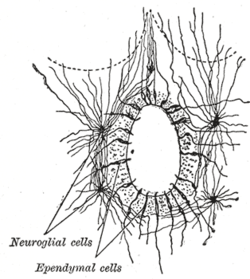Central canal
| Central canal of spinal cord | |
|---|---|
 Cross-section through cervical spinal cord. | |
 | |
| Details | |
| Identifiers | |
| Latin | canalis centralis medullae spinalis |
| TA | A14.1.02.019 |
| FMA | 78497 |
For the engineering project, see Indiana Central Canal.
The central canal, also known as ependymal canal, is the cerebrospinal fluid-filled space that runs longitudinally through the length of the entire spinal cord. The central canal is continuous with the ventricular system of the brain. The fourth ventricle narrows at a region called the obex to become the central canal of the spinal cord. The central canal helps to transport nutrients to the spinal cord as well as protect it by cushioning the impact of a force when the spine is affected
The central canal represents the adult remainder of the central cavity of the neural tube. It generally occludes (closes off) with age.[1]
Structure

Clinical significance
Syringomyelia is a disease caused by the occlusion of the central canal. Occlusions of the central canal typically occur at the lower cervical and upper thoracic levels. This typically damages white matter fibers that cross in anterior white commissure, leading to the loss of temperature, pain, and motor function at the affected levels on contralateral sides.
See also
References
- ↑ Yasui K, Hashizume Y, Yoshida M, Kameyama T, Sobue G (1999). "Age-related morphologic changes of the central canal of the human spinal cord". Acta Neuropathol. 97 (3): 253–9. doi:10.1007/s004010050982. PMID 10090672.
External links
- Anatomy diagram: 13048.000-3 at Roche Lexicon - illustrated navigator, Elsevier